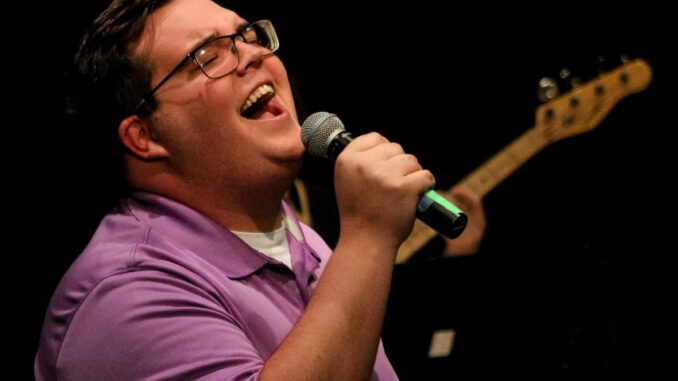
Sophie Perrino | Staff Writer
Sept. 29, 2022
Duquesne’s jazz ensembles gave us “something real” on Tuesday night when they held their first concert of the year. The event was a major success, drawing such a large crowd that many audience members stood.
Three groups and their instructors lit up Mary Pappert with a professional sound and an enthusiastic atmosphere. Students of all years participated in playing jazz standards and a variety of other complex pieces with fellow student musicians. There wasn’t a dull moment during the two-hour concert, as a mix of upbeat and slower arrangements featuring extraordinary solo improvisations by students kept the audience on their toes.
The night opened up with the vocal ensemble, led by Kelley Krepin DeFade. The group included students of all grade levels and featured soloists Nathan Sekela, Mary Rose Rudegeair, Miah Sirianni and Giulia Galante Golinelli.
DeFade’s students were accompanied by a rock-solid rhythm section, composed of pianist Alex Luketich, bassist Mitchell Fleischman, drummer Soojin Park, saxophonist Jake McCormick and Alex Weibel on the guitar.
One of their major highlights was a jazz standard, “Autumn Leaves,” by Johnny Mercer and Joseph Kosma. Miah Sirianni soloed on the up-tempo classic, while her fellow vocalists built harmonies reminiscent of the vintage late-40s sound.
They concluded their set with a Brazilian favorite, “Triste,” by Antonio Carlos Jobim. The song featured talented soloist Giulia Galante Golinelli. Golinelli is a Brazilian-born vocal performance major whose native language is Portuguese.
The group earned a chorus of cheers and set a tone of excitement for the rest of the night. Their instructor, DeFade, is a Pittsburgh singer, actor, and dancer, who studied at Youngstown State University and the Opera Theatre of Lucca in Italy. She has performed around the United States and the Pittsburgh region and passes down her talents to her students at Duquesne.
The vocal ensemble was followed by the jazz workshop, instructed by Pittsburgh local Jeff Bush. Students in the workshop performed jazz classics, several of which were arranged by Bush or Mike Tomaro.
Bush is a Pittsburgh native and jazz legend, studied trombone at Youngstown State University and the Manhattan School of Music. He has played with several of America’s famous groups such as the Glenn Miller Orchestra and the Cleveland Jazz Orchestra to name just a few.
His students described him as “extremely fun” to work with, and it was clear in their performance that he and the students in the workshop have developed a musical bond that allows them to feel comfortable going all-out in their playing and solos especially.
A highlight of their energetic set was “Blue Bossa,” by Kenny Dorham, a standard that Bush says, “everybody should know.” The piece featured incredible solos by students Max Elliot on the saxophone, bassist Connor Behary and trombonist Justin Clark. The soloists took an average 12-bar blues piece to the next level with dynamic improvisations, a demonstration of the expert skills they’ve developed in the jazz program.
Their cohesion as a group was a testament to “the ear you have to have” as a jazz musician, trombonist and recent Duquesne graduate Tim Roehrick said. Brennan Paulsen agreed, noting that jazz music is unique in that it brings out “interesting colors” within its many sounds and leaves” lots of room for self-expression.”
The night concluded with Mike Tamaro’s jazz ensemble, whose performances were nothing short of unbelievable. The group performed both ballads and fast-paced music, many of which brought their rhythm section to the forefront.
Their arrangement of “Give Me Something Real” by Clark Anderson and Mervyn Warren featured vocalist Nathan Sekela, who amazed audience members with his tone and vocal control.
The group moved from emotional to fast-paced by their last piece, “Fast Lane” by George Whitty, their most complex and exciting of the night. Guitarist Jacob Zang, trumpet player Jonah Hanlon and drummer Soojin Park stole the show with their solos.
Tamaro’s students made performing at the professional level look easy, demonstrating what Jonah Hanlon calls the “social art of communicating” without words. Hanlon was a high schooler sitting in a Panera Bread when he heard a Clifford Brown album playing over the speakers. He said he had been in love with jazz music ever since, describing a type of “fulfilment” and freedom that playing gives him.
Tamaro agreed, saying that jazz teaches musicians how to “musically react” to a variety of sounds and subtle cues from other players.
“Jazz is incredibly important to Duquesne’s history,” Tamaro said, describing jazz as a “mecca that has produced legends” such as trombonist Sammy Nestico. Duquesne’s jazz instructors are teaching students “to make a living being creative” in an ever-changing and prosperous musical environment.
Duquesne’s jazz ensembles will return for more exciting events in the first week of October, with CMC Jazz Workshops on Saturdays from 10a.m.-12p.m. and the This and That: Local Legends Redux at the PNC Recital Hall on Oct. 18.

